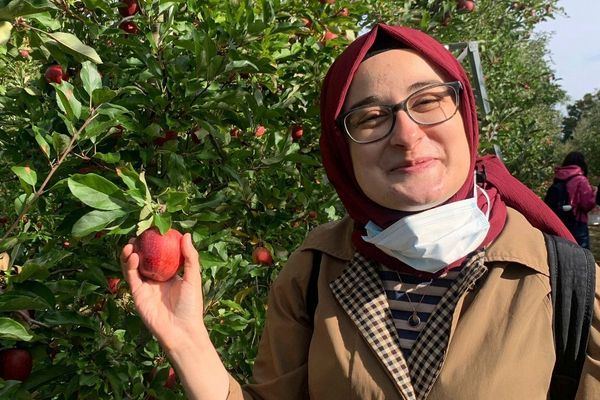
History is changing. More and more stories are being retold from different perspectives and with new analysis. Once you realise that the past is not a foreign country, but something that can be renovated, upgraded or restored, your worldview changes. Don’t like the environmental impact of avocado farming but love the taste? Make a new, locally produced fruit. Want to honour Scottish history but also provide a resource for literacy? Build the first scriptorium for 500 years. Read about these projects and more in this month’s design news.
For more news on architecture, sustainable living, art, fashion and new ideas, sign up for our monthly newsletter here
Remaking the avocado

When designer Arina Shokouhi became vegan, she hoped her new diet would benefit the environment. But then she found out how unsustainable the farming of her favourite fruit, the avocado, is. “Having resource-intensive fruit or vegetables out of season can be bad,” she says. “So, I thought a positive solution was to design a new local and low-impact version of the avocado.”
As Shokouhi points out, recent food start-ups have tried to replicate the taste and texture of meat and, most recently, seafood. But if you want a diet that curbs the environmental impact of emissions, water and land use, desirable but environmentally unsound vegetables should also be on the drawing board. The avocado has become as loved by influencers as by vegans, so the aesthetics of the fruit were also a consideration. The solution: the evocado, Shokouhi’s project for her masters in material futures at University of Arts London.
This British-made product was a collaboration with scientist Jack Wallman at the Food Innovation Centre in Nottingham, who helped her analyse the avocado and work on substitute ingredients for its delicate flavour. Hazelnut, apple and rapeseed are all in there, but the main constituent: broad beans. The alternative to the avocado stone: a walnut.
The evocado is not yet in production, but Shokouhi hopes to make it a commercial concern.
“Public attention on the need to tackle climate change is growing. Consumer consciousness of how we produce and consume resource-intensive imported food is a significant lever for reducing our climate footprint.”
She’s also interested in the cultural ramifications. “In the future, it would be fun to make some other ecovados for different countries. This first one was a British ecovado. What, for example, would Japanese ecovado be? What ingredients are local in Japan?”
The delights of the Design Library


Wappingers Falls, New York, does not look like a Mecca for fashion houses or internationally renowned designers, but this sleepy Hudson Valley village is home to The Design Library, an incredible patterned-textile archive tucked away in a converted 1907 fabric mill. Full of embroidery, wallpapers, lace, tapestries, silk garments and textile swatches, this is the largest collection of documentary material in the world. Over 7 million designs, some dating back to the 1750s, are stored here.
This unique resource was started 50 years ago by Susan and Herb Meller. Textile designer Susan shared a love of antiques with her husband, an investment banker. They started collecting wallpapers and fabrics created during the last 300 years, filing their finds away to form the library, which licenses textile patterns to companies around the world.
Now the mill’s secrets are available to the general public, too – in a new source book showcasing materials from the collection. The patterns are kept in four main design families – floral, geometric, ethnic and conversational – which are then categorised into 1,200 further sub-groups. New book Patterns Inside the Design Library showcases some of the finest examples. It also includes stories from the creatives who use the library from companies such as Clinique, Nike and Calvin Klein. Francisco Costa, creative director of Calvin Klein from 2003-2016, tells a delightful story of how a devore fabric from the library inspired a modern, laser-cut pattern in his 2009 collection, which was worn by Michelle Obama.
As Peter Koepe, the archive’s current owner, says in his introduction: “A designer never knows what he or she will find when entering The Design Library, but inspiration is guaranteed. That is the magic that happens when designers interact with this magnificent collection. It places patterns from the past into today’s most creative hands, sending them back into the world.”
Patterns: Inside the Design Library by Peter Koepke is published by Phaidon on 4 August, £59.95 (phaidon.com)
The first new scriptorium for 500 years

History is being reassessed for many reasons and in many different ways at the moment. And the commemoration of the 700th anniversary of the Declaration of Arbroath is no exception. The Declaration, for those who need to brush up on their medieval Scottish history, was a letter sent in 1320 to Pope John XXII calling for Robert the Bruce to be recognised as the rightful King of Scots, and freedom from English claims of sovereignty over Scotland. Written in Latin, it is a plea for national freedom and a valuable relic of 14th-century political and religious life in Scotland.
To mark the anniversary, Fife artist Bobby Niven has created the first working scriptorium in over 500 years. Set in the grounds of Arbroath Abbey, The New Scriptorium is a studio space for writers, poets and local groups, with a programme of public events managed by arts charity Hospitalfield. Its purpose is to showcase the significance of literacy and the power of the written word. Niven has already created many beautiful sanctuaries for creatives with his Bothy Project, which operates small, off-grid studio spaces for artists.
Niven designed the scriptorium as an homage to the history and skills of medieval times, including a green-oak frame and an interior inspired by contemporary manuscript illustrations. “We know that Arbroath Abbey had a very large community, including monks who could transcribe and illuminate documents and who bound early manuscripts into books,” explains Niven. “The ability to read and write and convey information and document history was as powerful then as it is today, and I wanted to reflect that activity in the design of the interior space.”
While the new building helps today’s inhabitants of Arbroath, Neil Gray, the culture minister for Scotland, thinks remembering the past is vital too. “Our historic environment, culture and literature play an important part in shaping our future and this new building is part of a legacy that will benefit generations to come.”
The New Scriptorium will be used to host the Year of Scotland’s Stories programme and local literary groups. Check the website for public events
Award-winning new designers


There are many inspiring designers who’ve finished their education this year, and some of the best names to look out for were showcased this month at New Designers – the UK’s largest and longest-running design graduate show. The halls of London’s Business Design Centre (BDC) were full of new ideas from bright minds exploring the possbilities of art, ceramics, fashion, furniture, graphic design, jewellery and woodwork.
In total, 36 prizes were awarded to standout students, and it’s easy to see how some of these could shape the world in years to come. Chloe Grieve from Edinburgh College of Art won BDC New Designer of the Year for Shape Play, a project that looked at how textiles could improve psychiatric healthcare spaces. Ryan Waterhouse from Bournemouth University also won the New Designer award for Terra Nova, a soil-nutrient monitor designed for the agricultural industry which measures the critical nutrients within topsoil and provides information to reduce soil degradation. Birmingham City University graduate Aamana Bibi Nawaz won the MADE.COM Collaboration Award for her Vlamp, a combination table lamp/vase aiming to bring light and nature into homes.
“It’s an honour to witness the journeys that the graduates have gone through in the last couple of years, and how those experiences have influenced their final-year work,” says Cheryl Carroll, events director of New Designers.
Celebrating chic trainer deadstock

While the number of trainer brands investigating sustainable production is on the rise, going second hand or vintage is still the greenest way to get new shoes. This is the message promoted by Mission: Deadstock, a new exhibition and auction for sneakerheads.
Dreamt up by Futurevvorld, a website covering sustainable streetwear, fashion and design, Mission: Deadstock is a project in two parts. First, 40 pairs of vintage trainers from the personal collections of obsessives such as Andrew Ng, founder of the Sneaker Preservation Society, and DJ Daniela Buck, sneaker influencer, were curated in an exhibition. The trainers –including Reebok Pump Dee Browns, a pair of Nike Air Icarus and some New Balance 990v3 – were exhibited in a pop-up show at the boutique Extra Butter in Manhattan’s Lower East Side in mid-July.
All the shoes from the show are now on eBay until 28 July, with the proceeds from their sale going to three charities: ReMake, which helps formerly incarcerated individuals make a new start; recycling organisation Fabscrap; and Housing Works, a New York-based charity fighting homeless and Aids.
Allen Zelden, co-founder of Futurevvorld, says: “With billions of sneakers manufactured, that’s millions of metric tons in carbon emissions released from the industry every year, notwithstanding the volume of sneakers discarded in landfill where they continue to pollute our air, with certain components taking up to 1,000 years to decompose.
“Beyond the health of our planet, our culture of overconsumption also leaves us in a constant unhealthy state of desire. Through this exhibition, we are excited to empower more conscious consumption.”
Futurevvorld is planning more vintage trainer pop-ups in other cities and countries, so Mission: Deadstock is very much alive.
To find out more, visit futurevvorld.com







